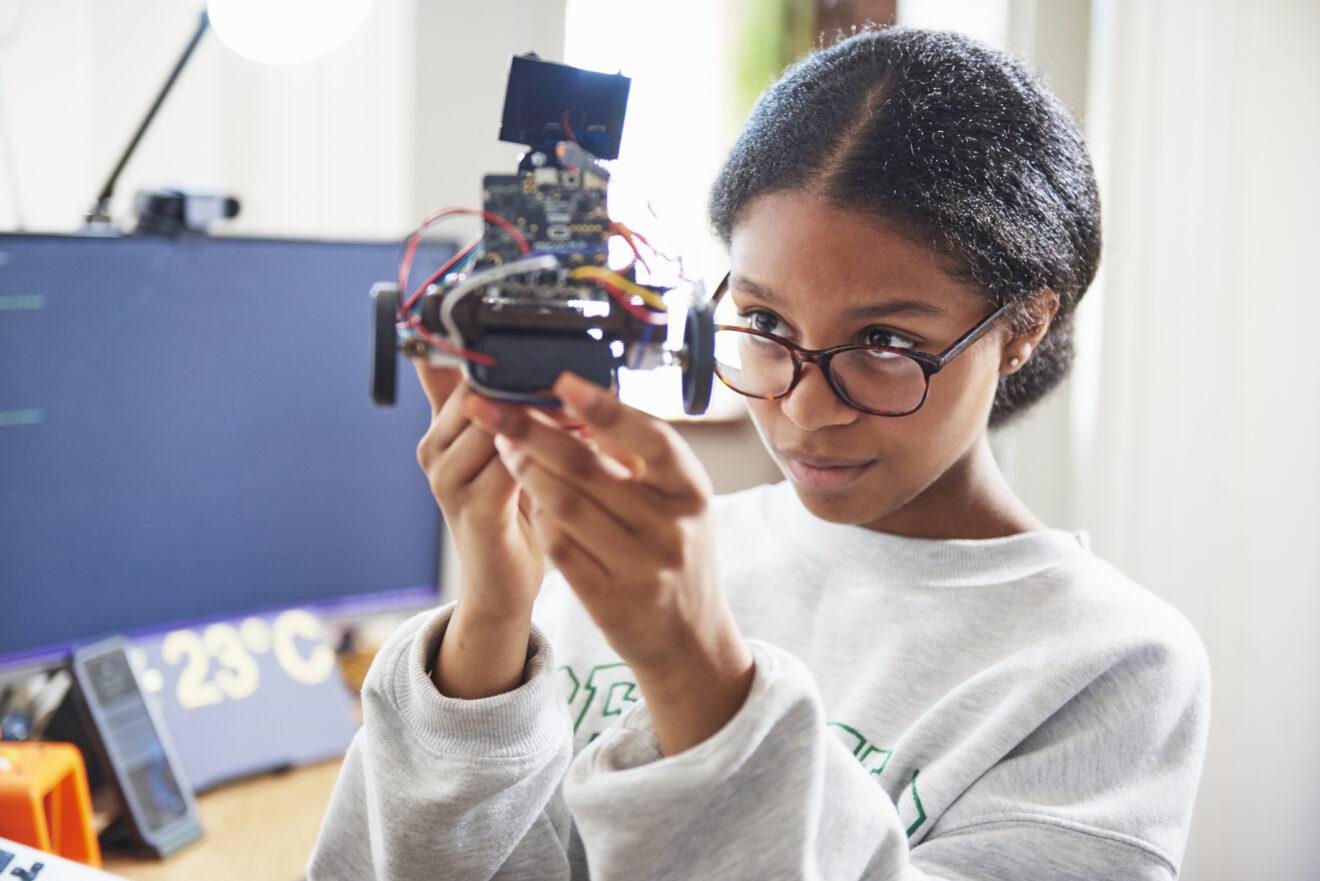Jonah Schenker, Ed.D., is the newly appointed district superintendent of Ulster BOCES. He recently sat down with Julianne Ross-Kleinmann, who works as an instructional data analysis and technology specialist for Ulster BOCES, to talk about her “Using the TPACK Framework to T.E.A.C.H.” presentation at the Learning Forward Conference. Ross-Kleinmann shared some thoughts about technology, TPACK, T.E.A.C.H., and why she thinks it’s important to be inclusive when teaching kids about technology.
Jonah Schenker: Could you please briefly explain TPACK and T.E.A.C.H.?

Julianne Ross-Kleinmann: TPACK is a framework created by Punya Mishra and Matthew Kohler in 2006. It breaks the skills that educators need to be able to teach students into discrete components. Teachers need to know what they are teaching, so one section is content knowledge. Teachers need to know what methods are best for teaching the particular content they are working on, so another component is pedagogical knowledge. And the third component is technological knowledge, which is knowledge of how to use tools effectively in teaching. Simply put, it’s a research-based framework for authentically integrating technology into your curriculum.
T.E.A.C.H. is an acronym I came up with when Mark Gura included a snippet I wrote for his book, “The Edtech Advocate’s Guide to Leading Change in Schools,” explaining how I helped teachers move from hating technology in the classroom to loving and using it. The acronym stands for “trust, equity, advocacy, collaboration and humor,” which were the tools I was using to help teachers change their mindset and approach to technology.
I started using these models together. TPACK provides a research-based framework that has been tested and shown to be valid. I wanted to bring teachers a model with which I knew people were successful and comfortable. As an education technology leader, T.E.A.C.H. gave me an approach based in andragogy, or the ways in which adults learn best. To implement something new, you first have to build trust.
Teachers and TPACK
Schenker: Why makes TPACK an effective model?

Ross-Kleinmann: Many people use a different model, called SAMR, which has not been verified to the same extent that TPACK. It’s also somewhat linear, so many people come away from it thinking of technology as a replacement for old tools — as if you can just swap in Google Docs for pencil and paper and you’re done integrating technology into your classroom.
TPACK is more parallel and recommends a continuous cycle of self-reflection of your teaching methods to guide further integration. It lends itself more to the vision of technology use as a literacy just like reading and writing. Teachers need reading in every subject because our students must read math problems and write to explain their learning in science classes. We need technology in all these subjects as well, in part because that is just the way the modern world works, but also because an important part of these subjects at the professional level is using technology to create. Scientists use technology to create models, geologists use them to monitor earthquakes, and mathematicians use them to solve complex equations. We need our students to not just be consumers of technology, but creators with technology, if they are going to be successful professionally.
Schenker: How can teachers use TPACK to improve their own teaching?
Ross-Kleinmann: Most teachers have a pretty good grasp of their content knowledge and pedagogical knowledge, though I’m sure most always strive to improve in both areas. TPACK adds technology, which is just a tool a teacher uses in delivering that knowledge and supports a student as they learn it.
A survey created by TPACK’s creators is a great tool to help teachers understand their current technological knowledge and identify gaps where they could improve. There are other surveys geared towards implementing TPACK as well, so teachers can return to self-assess over time in an effort to continue improving. Technology doesn’t stand still, so neither can we!
Challenges of integrating technology
Schenker: What are some challenges teachers face in implementing TPACK, and how do you help them overcome them?
Ross-Kleinmann: To help someone as a coach, you have to build a relationship. They have to trust you and that means advocating for them. I used to work at an independent school in Connecticut. On my first day there, I walked into a teacher’s classroom, and she said in front of the students and everyone else in the room, “I hate technology.” It was not the warmest greeting after I had just moved from another state.
But the reason she hated technology was because her Wi-Fi was awful and she had antiquated technology, because, as in a lot of schools, the older students got the new stuff and elementary classrooms got the leftovers. I would’ve hated it too. I had to advocate for her to get stronger Wi-Fi and work to convince the administration that early grades need good technology because that’s where you build your base.
I think a common struggle for teachers is not knowing what resources are available and feeling as if they have to start from the beginning. Sometimes there’s no network of people to give teachers a clear understanding of where to start. Sometimes there’s no staff developer or coach to help them use technology. Using the TPACK framework as a guide can help teachers figure out where to start and how to assess their progress.
Schenker: Where can teachers find support for integrating technology into their classrooms?
Ross-Kleinmann: Teachers don’t have to do this alone! They should find a professional learning network, perhaps through ISTE, FETC or other organizations. Colleagues in PLN freely offer answers to questions and other support resources.
Once in a PLN, teachers can jump on a message board with questions about anything from what kinds of headphones are best for a particular use, to help with lesson plans. PLN members are eager to share resources and ideas that they’ve already tried and troubleshot, so teachers don’t have to reinvent the wheel. Conferences, online tutorials, certifications, courses, free webinars, and Twitter chats can all help teachers build up their capabilities.
Embrace humor
Schenker: Why is humor important?
Ross-Kleinmann: A story I tell often is about a time early in my career when I called for help because the printer wasn’t working. The technician showed up, looked under the table and plugged in the printer. He asked if I wanted him to continue helping me and I said, “Yes, please!”
I like that story because it demonstrates that the only reason I know so much about classroom technology is because I’ve practiced with it a lot. In the beginning, I didn’t know what I was doing either, and I needed help as well to get to where I am.
Schenker: When using TPACK, what’s the best place for teachers to start?
Ross-Kleinmann: Another challenge for teachers adopting TPACK is they often want to start with the tool, but instead should start with what they want their students to learn and why. So someone might say to me, “I would love it if you could teach my kids PowerPoint.” I would teach their students some PowerPoint first, but after I gained the teacher’s trust, I’ll ask what they really want the students to do. It’s important to start with the why and then find the tools that best match.
Schenker: Technology can feel like a boys’ club at times. How does that affect your use of it in the classroom?
Ross-Kleinmann: As a technology person who’s a woman of color, I’m in a unique role where I typically don’t see people who look like me. It’s important to make sure you’re including everyone in the narrative. In regards to, say, computer science, it doesn’t have to wait until high-school math. There are so many fun and interesting ways that you can incorporate it (plugged and unplugged), starting in pre-K and kindergarten, to invite all of your students in. You just don’t know who you’re going to touch. I’ve seen shy kids bloom and become the head of the Scratch Club or join a robotics club because they found that one thing that just kicked it off for them. Everyone has something they can bring to the table, show others and be creative when they find the correct technology for them.
Schenker: How does your current employer foster a sense of engagement and belonging?
One thing I appreciate about Ulster BOCES is our North Star Commitments. In my new role at Ulster BOCES, I have received support to develop my unique self, develop my capacity, find ways to contribute to the community, and encouragement to engage in continuous cycles of inquiry as a lifelong learner.
“You’re not gonna break it”
Schenker: Do you have any other advice for teachers who are looking to better integrate technology into their instruction?
Ross-Kleinmann: Just try to have some fun! You’re not gonna break it. And, honestly, if you do, so what? You can get another one. Don’t be afraid. I’ve started so many after-school programs without knowing what I was doing. I didn’t know how to use NXT robots. I didn’t know Minecraft. But the kids did. I was the adult in the room and had to reach out to other adults for assistance, but if I didn’t do it, those students would never have had those experiences. They never would’ve started if they’d had to wait for me to be the full expert in the room. Don’t be afraid to just play around.
There is no one correct way to integrate technology into instruction. It’s going to vary according to the teacher, the subject matter, the students and their interests, what technology is available and familiar to everyone involved, and myriad other details. Instead, I work to help teachers build fluency in using technology to elevate their instruction and students’ learning, just as I hope to help students build fluency in using technology throughout their lives.
Julianne Ross-Kleinmann is an instructional data analysis and technology specialist at Ulster BOCES. She is an experienced administrator and instructional specialist with a history of working in primary, secondary, and higher education. She has a Master of Science in Elementary and Early Childhood Education, and another in Administration & Supervision. She is working on a doctorate in educational leadership.
Jonah Schenker, Ed.D., is the newly appointed district superintendent of Ulster BOCES, where he previously served as deputy superintendent. He can be reached at [email protected].
Opinions expressed by SmartBrief contributors are their own.
_________________________
Subscribe to SmartBrief’s FREE email ASCD newsletter to see the latest hot topics in education. It’s among SmartBrief’s more than 250 industry-focused newsletters.
